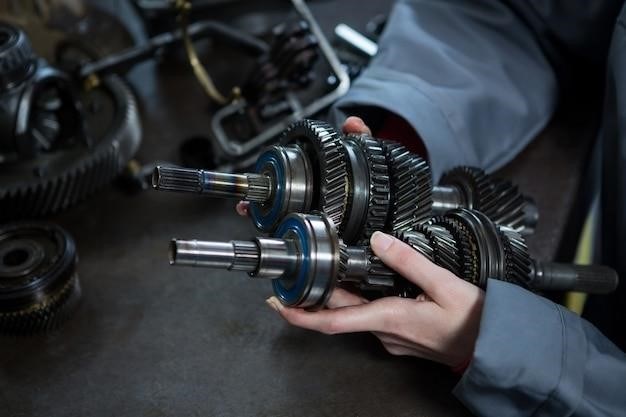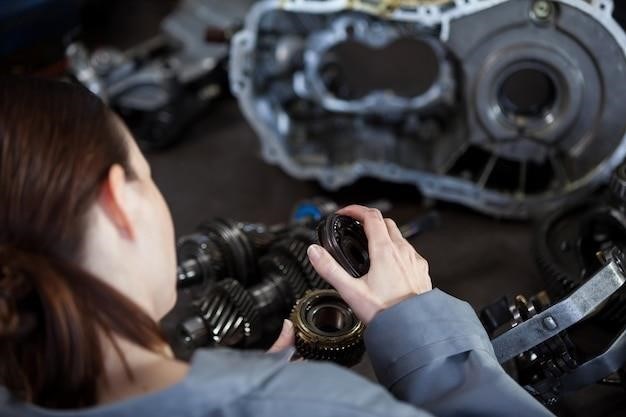Manual Gearbox Service⁚ A Comprehensive Guide
This guide provides comprehensive information on manual gearbox service, covering its importance, components, benefits, and signs of needing service. We will delve into the specifics of what a manual gearbox service entails, including fluid change, filter replacement, inspection and cleaning, and gasket replacement. We will also discuss the benefits of regular servicing and highlight key signs indicating your manual gearbox requires attention. Additionally, we will address the frequency of manual gearbox service and offer valuable insights to ensure your vehicle’s smooth and reliable operation.
Introduction
In the realm of automotive engineering, the manual gearbox stands as a testament to driver engagement and mechanical precision. This intricate system, responsible for transmitting power from the engine to the wheels, demands meticulous care and regular maintenance to ensure its optimal performance and longevity. A well-maintained manual gearbox not only enhances the driving experience but also safeguards against costly repairs down the line. While the simplicity of a manual transmission might seem straightforward, its internal components are subject to wear and tear over time, necessitating periodic service to maintain its efficiency and prevent potential issues.
This comprehensive guide delves into the world of manual gearbox service, exploring its significance, essential components, and the benefits of regular maintenance. We will shed light on the key aspects of a typical service, including fluid change, filter replacement, inspection and cleaning, and gasket replacement. Understanding these procedures and their importance will empower you to make informed decisions about your vehicle’s care, ensuring a smooth and enjoyable driving experience for years to come.
Importance of Regular Manual Gearbox Service
Regular manual gearbox service is not merely a matter of routine maintenance; it’s a crucial investment in the longevity and performance of your vehicle. Neglecting this vital aspect can lead to a cascade of problems, ranging from sluggish shifting and gear grinding to catastrophic transmission failure. The transmission fluid, the lifeblood of the gearbox, deteriorates over time, losing its lubricating properties and ability to dissipate heat effectively. This degradation can result in excessive wear on gears, bearings, and other internal components, ultimately leading to premature failure.
Beyond the mechanical implications, regular service also contributes to a smoother and more enjoyable driving experience. A well-maintained gearbox ensures crisp, precise shifting, enhancing driver control and responsiveness. Moreover, proactive service helps prevent costly repairs down the line, saving you both time and money in the long run. Investing in regular manual gearbox service is an investment in the overall health and longevity of your vehicle, ensuring reliable performance and peace of mind on the road.
What Does a Manual Gearbox Service Include?
A comprehensive manual gearbox service involves a series of essential tasks designed to ensure optimal performance and longevity. These tasks go beyond a simple fluid change and encompass a meticulous inspection and maintenance process. The service typically begins with draining the old transmission fluid and replacing it with fresh, high-quality fluid compatible with your vehicle’s specifications. This step is crucial for maintaining lubrication and heat dissipation within the gearbox. Next, the service often includes replacing the transmission filter, which traps debris and contaminants that can build up over time, preventing them from damaging internal components.
A thorough inspection of the gearbox is also a key component of the service. This involves examining the sump pump or pan (if accessible), checking for leaks and wear on seals, and inspecting the shift lever bushes. If necessary, the service may include cleaning the pan and replacing the pan gasket to ensure a secure and leak-free seal. Finally, a test of clutch operation and a check of the shift lever mechanism are performed to ensure smooth and reliable gear shifting.
Fluid Change
The transmission fluid, also known as gearbox oil, is a vital component of a manual gearbox, responsible for lubricating the moving parts and dissipating heat generated during operation. Over time, transmission fluid degrades, losing its lubricating properties and becoming contaminated with metal particles and debris. This can lead to increased friction, reduced gear shifting smoothness, and even premature wear and tear on the gearbox. Replacing the transmission fluid with fresh, high-quality fluid is essential for maintaining the gearbox’s performance and extending its lifespan.
The fluid change process typically involves draining the old fluid from the gearbox through a drain plug located at the bottom of the gearbox housing. Once the old fluid has been drained, the drain plug is replaced, and fresh transmission fluid is added through a filler tube or plug. The amount of fluid required varies depending on the specific gearbox model and is typically specified in the vehicle’s owner’s manual. It is important to use the correct type and quantity of transmission fluid for optimal performance.
Filter Replacement
While not all manual gearboxes have a dedicated filter, those that do rely on it to trap contaminants and debris circulating within the transmission fluid. This filter is typically located within the gearbox housing and acts as a barrier, preventing harmful particles from entering the delicate internal components of the gearbox. Over time, the filter can become clogged with accumulated debris, reducing its effectiveness and compromising the gearbox’s lubrication.

Replacing the filter during a gearbox service is essential to ensure the transmission fluid remains clean and free of contaminants. A clogged filter can impede fluid flow, leading to reduced gear shifting smoothness and potentially causing damage to the gearbox. The filter replacement process typically involves removing the gearbox housing, accessing the filter, and installing a new one. It is crucial to use a filter specifically designed for the particular gearbox model to ensure compatibility and optimal performance.
Inspection and Cleaning
A thorough inspection and cleaning are integral parts of a comprehensive manual gearbox service. During this process, technicians meticulously examine the gearbox for any signs of wear, tear, or damage. This includes inspecting the gears, bearings, seals, and other internal components for any irregularities or signs of malfunction. The inspection process involves visually assessing the components, checking for excessive wear, cracks, or any signs of metal shavings that indicate potential damage.
In addition to the visual inspection, the gearbox housing is thoroughly cleaned to remove any accumulated dirt, debris, or contaminants. This cleaning step is crucial to ensure optimal performance and prevent the buildup of harmful particles that can affect the gearbox’s functionality. The cleaning process often involves removing the gearbox pan, cleaning it thoroughly, and replacing any worn-out gaskets. By inspecting and cleaning the gearbox, technicians can identify potential issues early on, preventing more significant problems and ensuring the gearbox’s longevity and optimal performance.
Gasket Replacement
Gasket replacement is a crucial aspect of a manual gearbox service, ensuring a leak-proof seal and preventing fluid loss. During the service, technicians carefully inspect the existing gaskets for any signs of wear, tear, or damage. These gaskets, typically made of rubber or cork, are responsible for sealing the various openings and joints in the gearbox, preventing leakage of transmission fluid. Over time, these gaskets can become brittle, cracked, or warped due to heat, age, or exposure to harsh conditions.
If the inspection reveals any signs of damage or wear, the gaskets are replaced with new ones. This ensures a tight seal and prevents leakage of transmission fluid, which can lead to reduced lubrication, increased friction, and ultimately, gearbox damage. Replacing the gaskets during service helps maintain the gearbox’s optimal performance, ensuring proper lubrication and preventing premature wear and tear on the internal components.
Benefits of Regular Manual Gearbox Service
Regular manual gearbox service offers numerous benefits, extending the lifespan of your gearbox and ensuring optimal performance. One of the primary advantages is the prevention of costly repairs. By addressing potential issues early through routine servicing, you can avoid major breakdowns and expensive repairs. Regular fluid changes, filter replacements, and inspections help maintain optimal lubrication, reduce friction, and prevent premature wear and tear on internal components.
Moreover, regular service ensures smooth and efficient gear shifting, enhancing the overall driving experience. A well-maintained gearbox operates smoothly, providing precise and responsive gear changes. This translates to a more enjoyable driving experience, with improved acceleration, fuel efficiency, and overall performance. Additionally, regular service helps maintain the gearbox’s efficiency, reducing energy loss and improving fuel consumption.
Signs that Your Manual Gearbox Needs Service
Recognizing the signs that your manual gearbox needs service is crucial to preventing potential damage and costly repairs. One of the most prominent indicators is difficulty shifting gears. If you experience grinding, slipping, or a hesitant engagement of gears, it could signal a problem with the gearbox’s internal components or fluid levels. Another telltale sign is unusual noises emanating from the gearbox, such as whining, grinding, or clunking sounds, which might indicate worn-out bearings, gears, or other components.
Additionally, leaking fluid from the gearbox is a clear indication of a problem. If you notice any fluid leaks, it’s essential to address them promptly as it could signify a worn-out seal or a more serious issue. Furthermore, if you experience a burning smell coming from the gearbox, it could indicate overheating due to low fluid levels or a problem with the clutch. It’s important to address these signs promptly to prevent further damage and ensure the safe and reliable operation of your vehicle.
How Often Should You Service Your Manual Gearbox?
The recommended service interval for a manual gearbox varies depending on factors such as driving conditions, vehicle age, and manufacturer recommendations. However, a general guideline is to service your manual gearbox every 30,000 to 60,000 miles. If you frequently drive in harsh conditions, such as extreme temperatures, heavy towing, or frequent stop-and-go traffic, you may need to service your gearbox more often. It’s always a good idea to consult your vehicle’s owner’s manual for specific recommendations and to keep track of your service history to ensure you’re adhering to the recommended intervals.
Regular servicing helps maintain optimal gearbox performance, prolongs its lifespan, and prevents potential problems. Neglecting regular service can lead to premature wear and tear, reduced efficiency, and ultimately, costly repairs. By adhering to recommended service intervals, you can ensure your manual gearbox operates smoothly and reliably for years to come.
Maintaining a manual gearbox is crucial for ensuring optimal performance, longevity, and a smooth driving experience. Regular service intervals, as recommended by the manufacturer, are essential for preventing costly repairs and ensuring your gearbox operates efficiently. By staying vigilant for signs of gearbox issues, such as difficulty shifting, unusual noises, or fluid leaks, you can address problems early and minimize potential complications. Remember that a well-maintained manual gearbox contributes to a more enjoyable driving experience, enhanced fuel efficiency, and greater peace of mind.
If you’re unsure about the specifics of your manual gearbox service or have any questions, it’s always best to consult a qualified mechanic or your vehicle’s owner’s manual. By prioritizing regular maintenance and addressing any issues promptly, you can ensure your manual gearbox remains in top condition for years to come.
